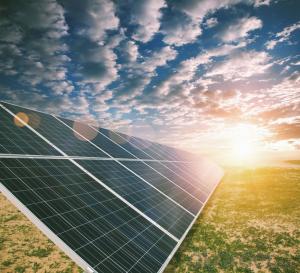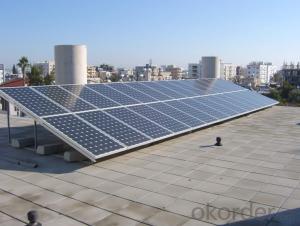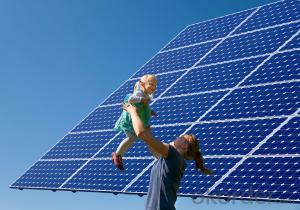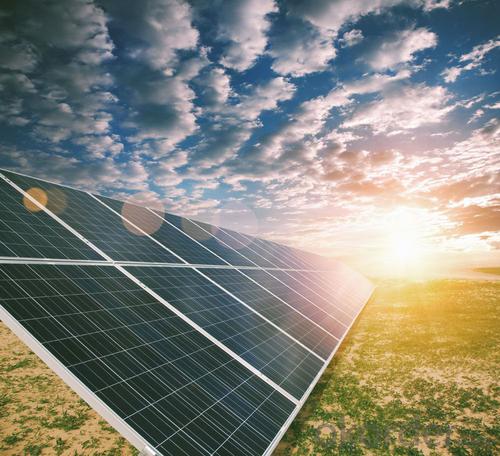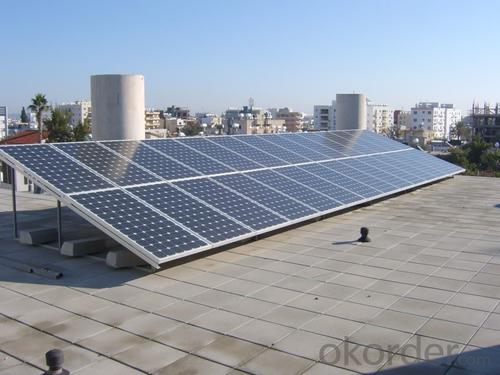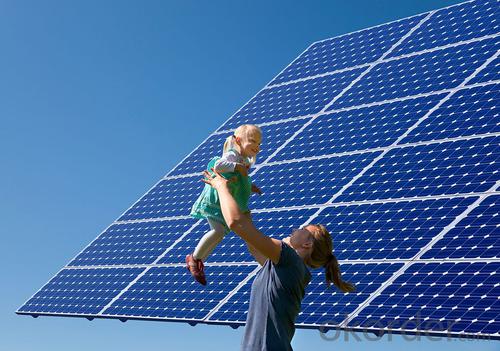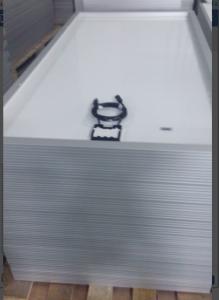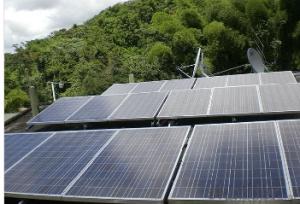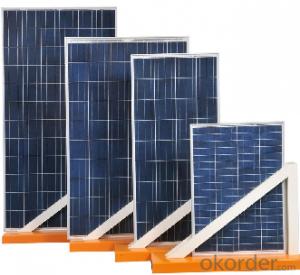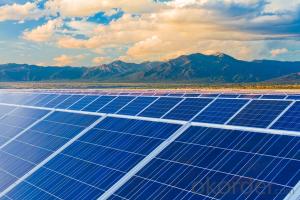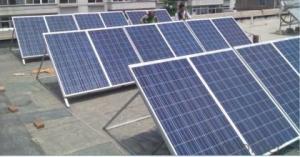Monocrystalline Silicon Polycrystalline Solar Panel 260W
- Loading Port:
- Guangzhou
- Payment Terms:
- TT OR LC
- Min Order Qty:
- 200000 watt
- Supply Capability:
- 20000000 watt/month
OKorder Service Pledge
OKorder Financial Service
You Might Also Like
ABOUT US
We are a high-tech group wich specializes in solar products design,research, manufacture, sales,solar projects design and installation.
Our national sales service covers seven parts, including northeast, north, east, middle, south, northwest and southwest, international sales covers five continents and over forty countries, including Germany, Italy, Spain, France, America and Brazil etc.
INTRODUCTION
This installation Manual contains essential information for the electrical and mechanical installation that your must know before installing CUSTOMER PV modules. This also contains safety information you need to be familiar with .All the information described in this manual are the intellectual property of CNBM and based on the technologies and experiences that have been acquired and accumulated in the long history of CUSTOMER. This document does not constitute a warranty, expressed or implied.
WORK PRINCIPLE
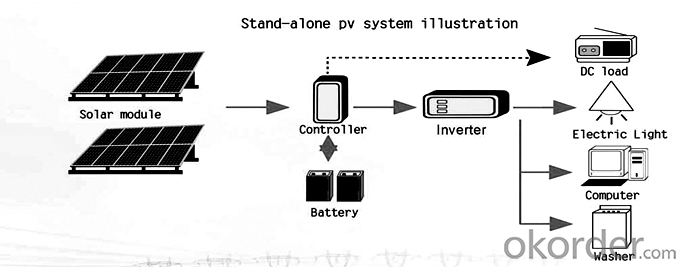
DATA SHEET
Maximum power | 260W |
Cell type(mm) | Polycrystalline solar cell 156*156 |
Number of cell(pcs) | 60(6*10) |
Manufacture site | China |
Open-circuit voltage(voc) | 37.6V |
Maximum power voltage(vmp) | 30.5V |
Short-circuit current(isc) | 8.95A |
Optimum operating current(imp) | 8.53A |
Power tolerance | 0~+5W |
Module efficiency | 16% |
Dimensions(mm) | 1640*992*40 |
Weight | 19 kg |
Backsheet | Silver |
Frame Colar | White |
Frame | Anodized Aluminum Alloy |
FAQ:
Q1: Why buy Materials & Equipment from OKorder.com?
A: All products offered byOKorder.com are carefully selected from China's most reliable manufacturing enterprises. Through its ISO certifications, OKorder.com adheres to the highest standards and a commitment to supply chain safety and customer satisfaction.
Q2: What is a solar PV module?
A: A solar PV module consists of many solar cells that are connected together (typically in series) and packaged in a frame (typically made of aluminum).
Q3: What is the typical service life of a solar PV module?
A: The typical life of a PV module is 25 years. However, superior quality PV modules boast service lives up to 35-40 years (electrical generating capacity is often reduced, however by that point).
Q4: What certifications do you have?
A: We are specialized in the photovoltaic field, with a focus on solar cells, modules and photovoltaic power generation systems. We employ advanced monocrystalline and polycrystalline silicon solar cell manufacturing equipment, producing highly efficient and reliable products sold in Europe, the Americas and Australia. Our company has passed ISO9001 quality management system certification, and our products have obtained TUV-IEC, CE and ISO certification.
- Q: Solar panels which is the one produces the power...I wanna the complete description about it...
- What they consist of is little bitty silicon particles that transport the electricity through thermal conduction. The sun's rays activate it and create a circuit. The advantage of solar energy is that it's clean and renewable. At this point in time, though, it's inefficient because you only get about 0 to 5 percent output. Also, we don't have the technology right now to save solar energy and store it into batteries so it can be used at night.
- Q: Can solar panels be installed on fences?
- Yes, solar panels can be installed on fences. In fact, fence-mounted solar panels are becoming increasingly popular as they provide an additional space-efficient solution for generating renewable energy.
- Q: Can solar panels be installed on billboards?
- Yes, solar panels can be installed on billboards.
- Q: (For a project)I know they are made of silicon, but I want to EVERYTHING they are made of. Ex Metal (What kind)Please tell me everything used from their production to the finished projectThank you
- Well i am not sure but to my knowledge all i know is that the purpose is to save solar cells which are later created into energy Solar energy is generated from solar panels. Solar panels are slabs of semi-conductor metal. Technically speaking, they are a slab of silicon semi-conductor doped or added with impurities to make it a better conductor. Solar panels could also be made of Gallium Arsenide which is a semi-conductor metal exclusively used in photo-voltaic cells. The silicon slabs are polished and glossed before doping. After processing, for protection, a thin glass layer is embossed on the solar cells slab. Silicon also is shiny and reflects about 35% of sunlight. Hence, an anti-reflective coating is usually applied over the slabs to reduce the amount of sunlight lost. Amorphous silicon solar panels are different from the traditional ones made from silicon slabs. Amorphous silicon solar cells are thinner and more efficient that the silicon ones and also the materials cost of this variety is far lesser than the traditional. Amorphous silicon slabs are developed with superior processes which makes them less susceptible to breakage during transportation. This makes them a more viable investment when it comes to buying solar panels.
- Q: looking for alternative ways to save energy money and thinking about solar panels. anyone know anything about it and how expensive it is to install them?
- Installing okorder
- Q: i want to join multiple solar panels into a bank so i only need one length of wire, i am going to use diodes to stop them sending power back into the one before it. is this ok or do i need something else?
- Maybe. It depends on the panels involved, and what their output is. Not all panels are able to be daisy chained.
- Q: Can solar panels be installed on a data center or server room?
- Yes, solar panels can be installed on a data center or server room. In fact, many organizations are increasingly adopting solar power as a sustainable energy solution for their facilities, including data centers and server rooms. Solar panels can be mounted on the roof or surrounding areas of the facility to generate clean and renewable electricity, reducing reliance on traditional energy sources and lowering carbon emissions. Integrated with appropriate infrastructure and storage systems, solar panels can effectively power these energy-intensive environments, making them more environmentally friendly and cost-effective in the long run.
- Q: Can solar panels be used on vehicles?
- Yes, solar panels can be used on vehicles. Solar panels can be installed on vehicles such as cars, trucks, boats, and even bicycles to generate electricity from sunlight. This electricity can be used to power various components of the vehicle, such as the battery, lights, or even the motor in some cases. Solar panels on vehicles offer a sustainable and renewable energy source, reducing reliance on traditional fossil fuels and contributing to a greener and more eco-friendly transportation system.
- Q: Can solar panels be installed on a data storage facility or server farm?
- Yes, solar panels can be installed on a data storage facility or server farm. Solar panels can be a sustainable and cost-effective solution to power these facilities, as they can generate electricity from sunlight and reduce reliance on traditional power sources. Additionally, the large surface areas often found on roofs or open spaces of these facilities can provide ample space for solar panel installation.
- Q: how the energy of load connected to solar PV measure.?Want too the basic idea about it.The role of current flowing thrugh the load?Can u explain with example..can explain simply?Im not an electrical student so explain very basics
- A solar panel is made up of solar cells. Each cell produces about 0.5 to 0.6 volts. Cells are connected in series, like the batteries in a flashlight. Enough cells are placed in series to produce the desired voltage. Cells produce very little current, so many strings of cells are connected in parallel to produce sufficient current. The output is direct current (DC), like that from a battery. A home solar system needs alternating current (AC), so an inverter is used to change from DC to AC. Some systems have batteries for backup power. In these some of the DC output is used to keep the batteries charged. Systems are measured in kilowatts. System sizes are chosen to meet the demands for electricity. My system has a 6 kilowatt (kW) rating. The true output is more like 4. Now that you know this much you can Google SOLAR SYSTEMS to learn more.
Send your message to us
Monocrystalline Silicon Polycrystalline Solar Panel 260W
- Loading Port:
- Guangzhou
- Payment Terms:
- TT OR LC
- Min Order Qty:
- 200000 watt
- Supply Capability:
- 20000000 watt/month
OKorder Service Pledge
OKorder Financial Service
Similar products
Hot products
Hot Searches
Related keywords
